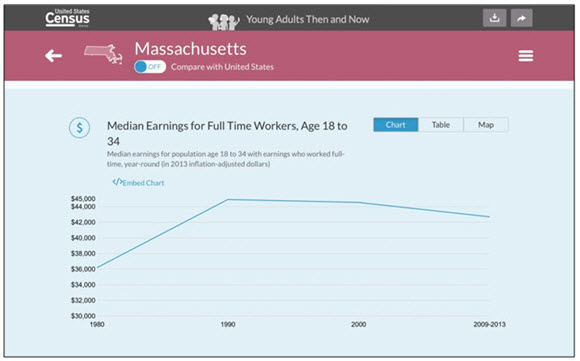Are Today's Young Adults Better Off Than Their Parents? Yes and No
Are Today's Young Adults Better Off Than Their Parents? Yes and No
Compared with prior generations, young people today, those 18 to 34 years old, are more educated and, in some parts of the country, earn more. However, they are also less likely to be employed and more likely to live in poverty than their counterparts were in 1980.
Although today’s typical 18- to 34-year-old earns about $2,000 less per year (adjusted for inflation) than their counterpart in 1980, the range varies widely across the country. Among the states with the largest growth in earnings for young adults is Massachusetts where they earn $6,500 more, and Virginia where they earn $4,100 more than the average young adult earned 30 years ago. Among the lowest are Michigan, Wyoming and Alaska where young adults earn at least $9,000 less than they did 30 years ago.
Similar geographic patterns play out for education, poverty and living arrangements, revealing that the generation of young adults who are doing better than their parents are concentrated in certain parts of the country.
Hubs in the Northeast (New York, New Jersey, Massachusetts) and South (Virginia, Maryland) have experienced near-double-digit growth in young college graduates, while the rest of the country has lagged. Since the 1960s, the Midwest has been a net loser of young adults who are college educated, as they have moved throughout the West and South.
The share of young adults who lived in their parents’ home stayed about the same level in 1980, 1990 and 2000 (at about a quarter). Since 2000, however, the proportion has shot up, from 23 percent to 30 percent. In states where housing markets collapsed during the recession, such as Nevada, Florida and California, there was a sharp increase in young adults living in their parents’ home. Similarly, Michigan, Ohio and Indiana — states also hit hard by the recession — saw some of the biggest growth in young adults living in poverty.
Young adults’ experiences may reflect a rise in inequality. Since the 1980s, income inequality for households and families has gone up at the same time as the country as a whole has become more educated [XLS <1.0 MB]. The picture that emerges from these statistics reveals a generation of young adults who may be, at once, both better and worse off than their parents.
Want to see how today’s young adults age 18-34 compare with their counterparts in 1980, 1990 and 2000? Check out “Young Adults: Then and Now,” the latest edition of Census Explorer, our interactive data tool. The new edition displays multiple characteristics of young adults over time. Users can “zoom in” to see data variations at the state, county, metro and tract levels.







